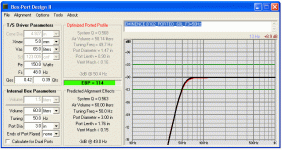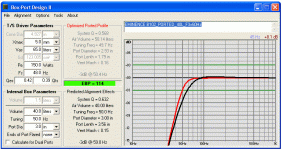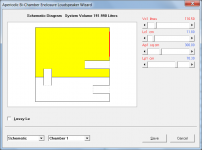I've build a DCR (dual chamber reflex) box with 40 cu in in one chamber and 84 cu in in the driver chamber. I understand it is a little better to have more in the speaker chamber. There seems to be two or more methods to figure the port size for my 3" speaker. Which is the correct method (or another?) plus I will make the third middle port the same but maybe test and adjust it to be shorter.
1. Simulate the 3" TS parameters in just the 84 cu in chamber with/without stuffing using 2 ports in the sim.
2. same but use the total volume of 124 cu in?
Would it be the same to simulate with one port, and use that figure for the other two?
The DCR box may or may not lower the f3 but I understand that it may have a little less distortion at high volume which is important for a small driver.
Thanks for any help?
1. Simulate the 3" TS parameters in just the 84 cu in chamber with/without stuffing using 2 ports in the sim.
2. same but use the total volume of 124 cu in?
Would it be the same to simulate with one port, and use that figure for the other two?
The DCR box may or may not lower the f3 but I understand that it may have a little less distortion at high volume which is important for a small driver.
Thanks for any help?
I don’t know how to simulate them one chamber at a time, but the rule of thumb is to have the larger driver chamber as V and each subsequent chamber reduced by 1/2 so V and 1/2V total. The vents are all the same in each chamber and the connector vent. Although I find the connector should be about 1/3 the main vents. I simulate it all in Akabak so no approximations needed.
1. Simulate the 3" TS parameters in just the 84 cu in chamber with/without stuffing using 2 ports in the sim.
That's the correct way.
Whether it's one port or two, just duplicate them for the lower chamber and the middle one.
The DCR box may or may not lower the f3 but I understand that it may have a little less distortion at high volume which is important for a small driver.
The DCR does not lower the f3. You tune the DCR to whatever f3 you want, just like in a ported box.
The difference in a DCR is the bottom chamber acts like a bandpass sub. Since the bandwidth is higher than the f3 in the upper chamber, it results in an additional "punch" in the upper bass. That's where the DCR makes a difference to the quality of the bass.

The plots above are from my latest DCR. The Blue plot is from the upper (larger) chamber. The Green plot is from the lower (smaller) chamber. Both taken at the mouth of the ports.
More information is at: LARK DCR
the old way (first to my recollection by George L. Augspurger) was to have an alignment (or total volume) divided into two chambers, one , twice the volume of the other. The whole volume using two external vents determined tuning.
In the classic DCR, the inner chamber vent was the same size as the other two. At system fb, the partition essentially becomes invisible and the entire volume is radiated by those two ports. A slow sweep of the system I think will show the ports working separately then together in phase This gave no extension vs a single volume with same parameters and tuning. It was characterized by a small notch in response and in driver excursion about an octave up from system resonance.
When the DCR article was first published, it was felt it did something rather special. Later, with better modeling, it was better explained.
Michael, I'll have to check your DCR. Hornresp should do some of them. Which driver T-S might work best in those type? (I've only made one for a VIfa 8" about 20 some years ago) Besides some B&C 15pzb20, I've the current Eminence B102 which might make a nice double chamber reflex.
here's what I get with 48 liters for B102 - look ok? what would you do different? (I'all be adding a Morel CAT 378 tweeter) https://i.imgur.com/o1jjmPt.jpg
In the classic DCR, the inner chamber vent was the same size as the other two. At system fb, the partition essentially becomes invisible and the entire volume is radiated by those two ports. A slow sweep of the system I think will show the ports working separately then together in phase This gave no extension vs a single volume with same parameters and tuning. It was characterized by a small notch in response and in driver excursion about an octave up from system resonance.
When the DCR article was first published, it was felt it did something rather special. Later, with better modeling, it was better explained.
Michael, I'll have to check your DCR. Hornresp should do some of them. Which driver T-S might work best in those type? (I've only made one for a VIfa 8" about 20 some years ago) Besides some B&C 15pzb20, I've the current Eminence B102 which might make a nice double chamber reflex.
here's what I get with 48 liters for B102 - look ok? what would you do different? (I'all be adding a Morel CAT 378 tweeter) https://i.imgur.com/o1jjmPt.jpg
Last edited:
Hi scott
I think there's some confusion. I'll take freddi's Eminence B102 as an example.
Ported Box Volume = 60 liters (see attachment)
Divide by 3 = 20 liters
Top chamber = 40 liters
Bottom Chamber = 20 liters
Use 40 liters to tune box. In the B102, it's 3" dia, length=3.56" for F3=60Hz.
Use this port dimensions for all three ports.
Hi fred
I'm afraid I'm not familiar with hornresp. I based my sim on the B102 spec sheet. Is your 48 liters the total volume?
BTW, I have the CAT 378 too. It's a wonderful tweeter.
I think there's some confusion. I'll take freddi's Eminence B102 as an example.
Ported Box Volume = 60 liters (see attachment)
Divide by 3 = 20 liters
Top chamber = 40 liters
Bottom Chamber = 20 liters
Use 40 liters to tune box. In the B102, it's 3" dia, length=3.56" for F3=60Hz.
Use this port dimensions for all three ports.
here's what I get with 48 liters for B102 - look ok? what would you do different? (I'all be adding a Morel CAT 378 tweeter)
Hi fred
I'm afraid I'm not familiar with hornresp. I based my sim on the B102 spec sheet. Is your 48 liters the total volume?
BTW, I have the CAT 378 too. It's a wonderful tweeter.
Attachments
yeah - 48 - if ever built then might go a bit larger and somewhat lower tuning - I think a K-tube for some instances would beat a 378 - the tube is a lot louder and subjective dispersion wider https://i.imgur.com/ZUWOcVl.jpg
Last edited:
Now I really confused. I appreciate all the comments and I have already built and separated the chambers in 1/3 and 2/3. Maybe I misinterpreting the comments since I think one comment was to use the total volume to figure the ports and another to use just the large chamber. Did I misunderstand that? Let me ask a different way:
1. Using a bass reflex simulator, do I enter the larger chamber (84) or do I enter the total (124)?
2. Then do I enter a "1" for 1 port or "2" for 2 ports. I know then to use the port's length and diameter for all three ports.
Thanks
1. Using a bass reflex simulator, do I enter the larger chamber (84) or do I enter the total (124)?
2. Then do I enter a "1" for 1 port or "2" for 2 ports. I know then to use the port's length and diameter for all three ports.
Thanks
I usually think of a DCR having approximately the same LF response, internal volume and tuning as a single chamber reflex with the same volume and tuning for a given driver. I think there are other approaches and tuning juggling but am not familiar.
in the case below, hornresp says my 48 liter DCR has about the same systerm tuning (around 48Hz) as a single chamber reflex when both have the same total vent (to the external world) area and vent length. It will be interesting to hear from Michael and others. You can see system tuning is about the same, but at octave above tuning, the DCR has a lot different behavior. (assuming the connecting vent is not heavily damped)
does this make sense?

in the case below, hornresp says my 48 liter DCR has about the same systerm tuning (around 48Hz) as a single chamber reflex when both have the same total vent (to the external world) area and vent length. It will be interesting to hear from Michael and others. You can see system tuning is about the same, but at octave above tuning, the DCR has a lot different behavior. (assuming the connecting vent is not heavily damped)
does this make sense?

Now I really confused. I appreciate all the comments and I have already built and separated the chambers in 1/3 and 2/3. Maybe I misinterpreting the comments since I think one comment was to use the total volume to figure the ports and another to use just the large chamber. Did I misunderstand that? Let me ask a different way:
1. Using a bass reflex simulator, do I enter the larger chamber (84) or do I enter the total (124)?
2. Then do I enter a "1" for 1 port or "2" for 2 ports. I know then to use the port's length and diameter for all three ports.
Thanks
Hornresp can show you in 'real time' how changes to the chamber and port tube sizes will affect the system response.
Attachments
1. Using a bass reflex simulator, do I enter the larger chamber (84) or do I enter the total (124)?
2. Then do I enter a "1" for 1 port or "2" for 2 ports. I know then to use the port's length and diameter for all three ports.
Thanks
Use the larger chamber - 84.
Use 1 for port. Choose the best diameter and length to suit you DCR.
with hornresp, I think the other type of reflex with 2 chambers, but only one vent to the external world can be investigated by shutting off one vent either with hornresp's "wizard" by sliding vent area and length to "zero" or manually entering "0.1" in desired areas. Also, assume both external vents could be shut off to simulate something like the old SEAS - Dynato A35 type boxes - dunno about damping the connecting vent (?)
Planet10 has a very nice page on the Dynaco boxes
Dynaco Enclosure Plans
Planet10 has a very nice page on the Dynaco boxes
Dynaco Enclosure Plans
Last edited:
Thanks Michael, that answers my question - use the larger chamber and enter one port dimensions then build another external port in the smaller chamber with same dimensions. For the connecting port, start off with same dimension but test it and I may need to make it as much as .33 times smaller.
Does anyone have an idea how to adjust the length of the connecting port without opening the enclosure? Maybe a thin wood rod to push/pull an adjustable port (tube inside another tube.) Then using a spl meter, when the port is at the correct length, cut off the protruding exterior part of the rod and fill in with wood putty?
Does anyone have an idea how to adjust the length of the connecting port without opening the enclosure? Maybe a thin wood rod to push/pull an adjustable port (tube inside another tube.) Then using a spl meter, when the port is at the correct length, cut off the protruding exterior part of the rod and fill in with wood putty?
here's an older Techtalk discussion
How to Design a Double Chamber Reflex System -
Techtalk Speaker Building, Audio, Video Discussion Forum
plus a pdf from Audio Heritage site of George Augspurger's 1961 article
http://www.audioheritage.org/vbulletin/attachment.php?attachmentid=58786&d=1366728116
How to Design a Double Chamber Reflex System -
Techtalk Speaker Building, Audio, Video Discussion Forum
plus a pdf from Audio Heritage site of George Augspurger's 1961 article
http://www.audioheritage.org/vbulletin/attachment.php?attachmentid=58786&d=1366728116
David McBean illustrated how hornresp can simulate a two chamber box with no external ports (as Dynaco/SEAS did with A35, A40XL (?) & A50) - I remember my late friend Don Nicol who owned Huntington WV's "High Fidelity Center" first showroom with A50 and Stereo 120 amplifier - "nice"
at low levels, it appears the technique could reduce excursion in a certain area.

at low levels, it appears the technique could reduce excursion in a certain area.

- Status
- This old topic is closed. If you want to reopen this topic, contact a moderator using the "Report Post" button.
- Home
- Loudspeakers
- Full Range
- DCR (dual chamber reflex) which port method is correct




